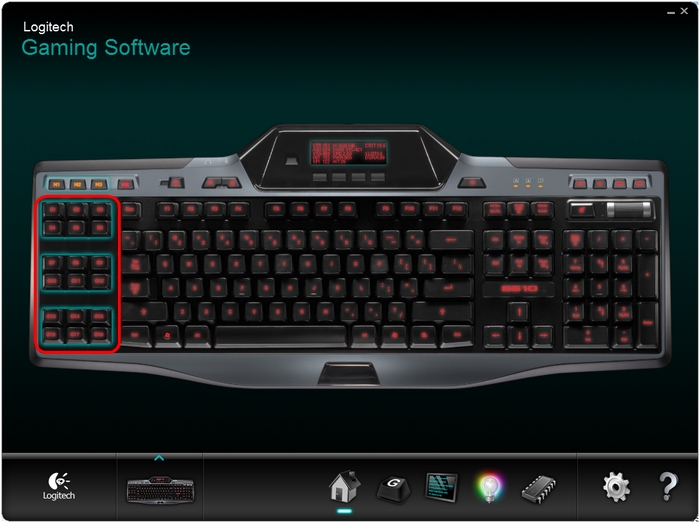Logitech Gaming Software enables you to program different G-Key configurations for each profile on your computer. To learn how to create and assign application-specific profiles, see answer 360023407553.
NOTE: If you're new to Logitech Gaming Software or you want to use only one profile with your keyboard, first follow the steps in answer 360023407553 to set up your Default Profile as a Persistent Profile.
To configure your G-Keys:
-
Open the Logitech Gaming Software:
Start > All Programs > Logitech > Logitech Gaming Software 8.x
-
Click the glowing G-Keys.

-
Select the profile you want to edit by clicking its icon. The profile will have a blue highlight bar above it when selected (ex. "Default Profile" below).
NOTE: Logitech Gaming Software will detect some games you've installed and create profiles for them. You can create profiles for other games yourself (see answer 360023407553 for help).

-
To edit a key, either:
- Drag and drop an existing command onto it.
NOTE: All commands you've created for that profile will be visible in the Commands list on the left. When you drag a command over the keyboard, the configurable keys will highlight. Choose the key you want to program and drop the command on top of it.
OR
- Right-click on a key and select Edit… This pop-up window will appear:

In this screen, you can assign your G-Key as a:
- Keystroke - Assign a single key press, or a key press with modifiers.
- Multi Key - Assign a "macro'd" series of keystrokes. (NOTE: You can set up these macros to function both with and without recorded time delays.)
- Text Block - Create a block of text to be typed out when the key is pressed (either with or without Unicode support).
- Mouse Function - Assign a G-Key on your keyboard to use any of the available mouse button functions.
- Media - Set a key to function like a media key.
- Hotkeys - Use a pre-defined keystroke command.
- Shortcut - Assign a key to launch a file/folder/drive on your computer.
- Function - Assign a key to act like a Microsoft function key (ex. to open your web browser).
- Ventrilo - Assign a key to have a function in Ventrilo, if Ventrilo is installed on your PC
After you select the function to assign the key, click OK. This will apply the new function and you'll see it named over the key in the window (ex. keys labeled "Forward", "Back", "Left", and "Right" below).

- Drag and drop an existing command onto it.
To unassign a G-Key, either right-click and select "Unassign", or drag the command from the key to the trash icon in the LGS window.
Important Notice: The Firmware Update Tool is no longer supported or maintained by Logitech. We highly recommend using Logi Options+ for your supported Logitech devices. We are here to assist you during this transition.
Important Notice: The Logitech Preference Manager is no longer supported or maintained by Logitech. We highly recommend using Logi Options+ for your supported Logitech devices. We are here to assist you during this transition.
Important Notice: The Logitech Control Center is no longer supported or maintained by Logitech. We highly recommend using Logi Options+ for your supported Logitech devices. We are here to assist you during this transition.
Important Notice: The Logitech Connection Utility is no longer supported or maintained by Logitech. We highly recommend using Logi Options+ for your supported Logitech devices. We are here to assist you during this transition.
Important Notice: The Unifying Software is no longer supported or maintained by Logitech. We highly recommend using Logi Options+ for your supported Logitech devices. We are here to assist you during this transition.
Important Notice: The SetPoint software is no longer supported or maintained by Logitech. We highly recommend using Logi Options+ for your supported Logitech devices. We are here to assist you during this transition.
Frequently Asked Questions
There are no products available for this section
